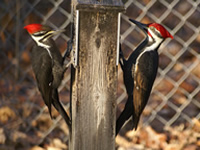Woodpeckers
[audio:woodpecker.mp3|titles=Woodpecker Sounds]
Peak Nuisance Period: Most damage occurs from March through June. In the early spring, they drum to proclaim their territories and attract mates. Then they’ll create nest cavities. However, from summer through fall, they seek insects and roosting sites. They may forage, nest, or roost in buildings.
Common Nuisance Situations:
- Drumming. In the spring, woodpeckers will peck on a variety of resonant objects, such as a hollow or dry tree; aluminum siding; metal roofs, gutters, drainpipes, chimneys, chimney caps,vents, stove and pipes; cars; canoes; mailboxes; garbage cans; the trim and fascia boards of a wood, brick, or stucco building; and even metal road signs. Drumming may leave small, shallow dents in wood, usually no more than 1″ across. Look for the dents clustered along the corners of buildings, or on the trim or fascia boards. Some people may find the noise annoying.
- Chiseling foraging holes in wooden buildings (siding, eaves, trim boards, even window frames)or utility poles. Certain building materials are more prone to insect invasion, such as grooved plywood siding (a.k.a. “T-111,” a mimic of board-and-batten siding), so they’re more vulnerable to woodpecker damage, too. Woodpeckers also prefer anything made of cedar.
- In T-111, look for this sign of woodpecker feeding damage: horizontal rows of small holes across the siding or the fascia.
- Cedar clapboards, resawn shakes, tongue-and-groove, or board-and-batten siding: very small holes clustered on the fascia boards (could also be caused by drumming).
- Cedar shakes or shingles: in addition to the very small holes clustered on the fascia boards, you may see: vertical rows of 3–6 small holes that follow the crack between two shingles up into the overlapping shingle; or large and small holes along the corners of the building, at the bottom of the shingle; or holes clustered near wires, which the woodpeckers used as perches.
- Drilling larger holes into wooden buildings to create roosts and nests. These holes are usually only slightly wider than the bird, and are either round, rectangular, or gourd-shaped. They seem to prefer a hard outer shell and soft inner cavity, which they usually find in a dead tree—or cedar building. They will drill into the insulation, in which they’ll hollow out their nest or roost. Woodpeckers often create several holes before settling down to business. Nesting holes are excavated late April–May. Roosts are usually created in the late summer through fall, as the birds prepare for winter. Woodpeckers are more likely to excavate roosts and nests in buildings with board-and-batten, clapboard, or tongue-and-groove siding than those with shingles or shakes.
- In cedar clapboards: nest and roost holes are usually drilled on the seam between two clapboards, and may be found throughout the siding.
- In board-and-batten: these holes are usually seen on the batten between two boards,throughout the siding (some preference for corners).
- In tongue-and-groove: corner holes are more typical, but you may see at the seam of two boards.
- In resawn shakes and shingles: generally, corner holes, usually between two shingles,where the top and bottom meet.
- Sapsuckers may also feed on ornamental or fruit trees, boring a series of small holes (1/4–3/8″)in parallel rows in the trunks or branches of healthy trees. (Nearby trees of the same species may be left untouched.) These holes sometimes girdle the tree, and create wounds that may be invaded by insects or diseases.
There are 6 types of woodpeckers found in the Got Wildlife? LLC service area.
- Downy woodpecker
- Hairy woodpecker
- Yellow-bellied sapsucker
- Red-bellied woodpecker
- Northern (a.k.a. “common”) flicker
- Pileated woodpecker
Animal Characteristics
Description: The downy woodpecker is the smallest, at 6 1/2″. The sapsucker and the hairy woodpecker are both 8–9 1/2″ (hairy looks like a larger version of the downy). The red-bellied woodpecker is 9–10 1/2″, and the flicker is 12–14.” The pileated is the largest, about the size of a crow, at 16–19 1/2″. Woodpeckers are diurnal, with peaks at dawn and dusk. Some Woodpeckers migrate. The Downy, hairy, red-bellied, and pileated woodpeckers remain in New York all year. Flickers in northern New York migrate, but those in the southern regions remain. The sapsucker migrates. Woodpeckers do not hibernate.
Diet: Mostly wood-boring insects, but they’ll also eat berries, beech nuts, acorns, seeds, fruits, and suet. Sapsuckers also feed on tree sap (surprise) and the inner bark of trees. Poison ivy berries are a winter staple for them. Woodpeckers eat insect pests, such as carpenter ants (a winter staple for the pileated),woodboring ants and beetles, bark lice, wasps, and carpenter bees. Flickers feed on ants on the ground. The other woodpeckers feed on trees. Red-bellied woodpeckers cache food.
Habitat: Open mixed woods with dead trees (some prefer bottomlands), woodland edges, orchards, rural, suburban, and urban areas with trees (especially if there’s a good supply of suet), parks. Some woodpeckers use wooded swamps, fields and meadows, and some need large trees. The pileated likes a larger area that combines second-growth and mature trees, often near a river or wooded swamp. Redbellied woodpeckers prefer to nest in dead limbs in living trees, competing with starlings for these cavities. Sapsuckers prefer to nest in aspens, and in trees with rotten heartwood. Some woodpeckers create new cavities each year (downy and hairy) while others reuse their holes (flicker).
Breeding: They mate April – June. They may have 2 – 3 broods/year. Eggs hatch in 12 to 18 days. Typical clutch size is 3-7.
MythBusters: n/a
